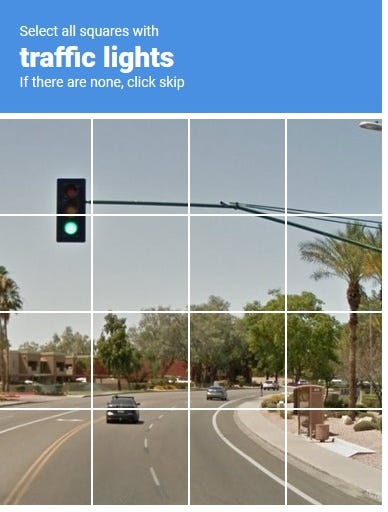Shiny Fixed Alternatives
Lightbulb moments in Elizabeth Bishop, Walter de la Mare and George Oppen
This smoky winter morning—
do not despise the green jewel shining among the twigs
because it is a traffic light
Charles Reznikoff (1934)
I wrote last year about the brief craze for getting ChatGPT to write doggerel about mundane subjects — and why I don’t think AI poetry is going to improve.
This post is not about AI-generated poetry. But it begins with a question prompted by it: why did people ask ChatGPT to write poems about traffic lights? One attempt went viral as an example of how — in the words of the Reddit user who shared it — “the poem quality glow up with GPT-4 is genuinely insane”. It began:
In the heart of a city’s bustling night,
A sentinel stands with glowing light,
With colors of red, yellow and green,
A triad of hues, a silent machine
Another, generated by a user in the Oregon Department of Transportation, began:
Traffic signals shining bright
Guiding us through the night
Red, yellow, green they glow
Controlling the flow of cars below
As these examples show — and as perhaps the users who requested them guessed — traffic lights are an ideal subject for an AI poem: a simple but colourful image, with a practical function and a predictable pattern of behaviour, which can be elaborated with cliches and slotted into the wise-sounding template of the rhyming couplet. Asking AI to write a poem about traffic lights is like getting dolls to kiss: the traffic light is a kind of AI, computing and communicating in its three-word language.
ChatGPT’s traffic light poems have a sense of poetic form and decorum but no human interest, because the programme was not prompted to express anything but rhapsodic cheerfulness about unsleeping road signals. Yet unease is exactly what real poets have felt about one of the most fundamental inventions of modernity: electric lights.
T.E. Hulme, the modernist philosopher and poet, saw over a century ago that he was living in an age defined by its lights:
Why is it that London looks pretty by night? Because for the general cindery chaos there is substituted a simple ordered arrangement of a finite number of lights.
The prettiness of the electrified streets of a modern city is satisfying because it is a comforting embroidery of the “chaos” that underlies it. Hulme described this chaos in pre-electric terms as “cinders”, arguing that “the absolute” — that is, in metaphysics, the ultimate reality — “is […] essentially imperfect, chaotic, and cinder-like”.
Hulme’s glittering cityscape might be imagined as an ironically earth-bound version of what its light pollution erases: the mythological creatures of the constellations (one of his poetic fragments reads: “Down the long desolate street of stars”). Later in the century, Elizabeth Bishop also felt the mythical power of this new, illuminated world. In her poem “Late Air” (1946), she writes of the radio mast that broadcasts love songs, but which itself is home to “better witnesses / for love on summer nights”:
Five remote red lights
keep their nests there; Phoenixes
burning quietly, where the dew cannot climb.
Love songs, Bishop suggests, are ephemeral stimulants for passing emotions (“their marrow-piercing guesses are whatever you believe”). Her “better witnesses” for romantic love are a remote, fixed, perpetually burning, imaginary breed of beings.
Bishop also wrote about the lights of pedestrian crossings, at the end of her poem “Night City” (1972). Subtitled “[From the plane]”, it describes the urban scene below in ominously blurred, bright and riddling images of pollution and disorder (“spatter outward / in clots of gold”). Some kind of traffic control light — evoked with deliberate vagueness — appears in the final stanza as a benign, angel-like presence:
(Still, there are creatures,
careful ones, overhead.
They set down their feet, they walk
green, red; green, red.)
This might, in isolation, be a couplet from a ChatGPT poem about a pedestrian crossing signal in one of the many countries around the world where illuminated figures alternate red and green. But Bishop’s poem is written with what AI lacks: a sense of irony about poetry itself, and the ability to break with form for effect.
Keep reading with a 7-day free trial
Subscribe to Some Flowers Soon to keep reading this post and get 7 days of free access to the full post archives.







